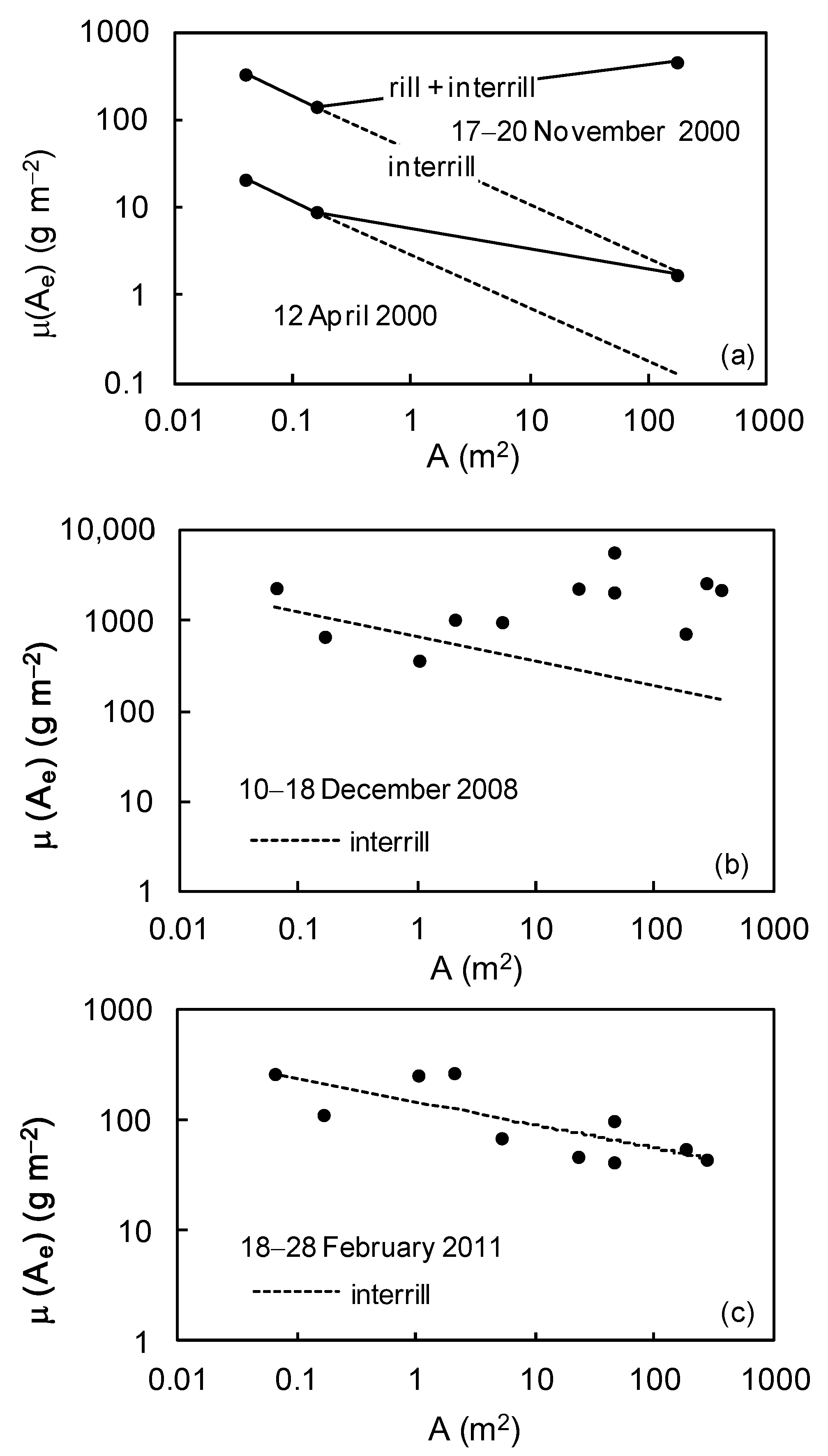Measurement of Water Soil Erosion at Sparacia Experimental Area (Southern Italy): A Summary of More than Twenty Years of Scientific Activity
Abstract
:1. Introduction
2. A Brief Summary on Soil Loss Measurement in the Literature
3. Measurement of Total Erosion at Sparacia
3.1. Measurement Methods
3.2. Experimental Results
3.2.1. Effects of Plot Size and Steepness
3.2.2. Measurement Variability and Physical Model Concept
3.2.3. Statistical Analysis of Soil Loss Measurements
4. Measurement of Rill Erosion at Sparacia
4.1. Measurement Methods
4.2. Experimental Results
5. Comparing Interrill and Rill Erosion
6. Conclusions
- The long-term average soil loss per unit area generally did not vary appreciably with the plot length because the decrease in runoff coefficient was offset by an increase in sediment concentration. Moreover, the analysis at the event scale suggested that soil loss per unit area most frequently decreased in longer plots. In any case, these results were not consistent with the assumption made in the USLE/RUSLE model. On the contrary, the long-term steepness effect was well reproduced by the predictive relationships of the USLE/RUSLE slope steepness factor;
- The relative variability of soil loss, runoff volume, and sediment concentration decreased as the mean measured value increased, and soil loss measurements were generally more variable than runoff volume and sediment concentration. In order to account for the natural variability of the soil loss measurements in the evaluation of the predictive capability of the erosion models, a new applicative criterion of the physical model concept was developed using measurements performed at the Sparacia and Masse experimental stations;
- In the sampled site, for a given plot length, the soil loss of a given return period can be estimated by multiplying the mean soil loss by a frequency factor. The latter is determined by fitting Gumbel’s distribution to the two components of the frequency distribution of the normalized event soil loss;
- The measurements of the rill volumes and lengths allowed us to verify the reliability of a power relationship between the two variables. The measurements also confirmed the morphological similarity between the channels of the rills and EGs described by a power dimensionless relationship;
- The rill erodibility of the clay soil of Sparacia was estimated by a simplified method, which was also validated by using the WEPP database. Rill erodibility varied over time, maintaining relatively low values;
- The reliability of the SfM technique to measure rill erosion was positively tested;
- For the contributing rills, the drainage density increased, indicating a more efficient sediment transport system as plot steepness increased;
- As a general result, rill erosion was dominant relative to interrill erosion.
Author Contributions
Funding
Institutional Review Board Statement
Informed Consent Statement
Data Availability Statement
Conflicts of Interest
References
- Di Stefano, C.; Ferro, V.; Pampalone, V.; Sanzone, F. Field investigation of rill and ephemeral gully erosion in the Sparacia experimental area, South Italy. Catena 2013, 101, 226–234. [Google Scholar] [CrossRef]
- Bagarello, V.; Ferro, V.; Pampalone, V. A comprehensive check of USLE-based soil loss prediction models at the Sparacia (south Italy) site. In Innovative Biosystems Engineering for Sustainable Agriculture, Forestry and Food Production, MID-TERM AIIA 2019; Coppola, A., Di Renzo, G., Altieri, G., D’Antonio, P., Eds.; Lecture Notes in Civil Engineering; Springer: Cham, Switzerland, 2020; Volume 67, pp. 3–11. [Google Scholar]
- Bagarello, V.; Ferro, V.; Pampalone, V. A comprehensive analysis of USLE-based models at the Sparacia experimental area. Hydrol. Process. 2020, 34, 1545–1557. [Google Scholar] [CrossRef]
- Bagarello, V.; Ferro, V.; Flanagan, D.C. Predicting plot soil loss by empirical and process-oriented approaches. A review. J. Agric. Eng. 2018, 49, 1–18. [Google Scholar] [CrossRef]
- Bagarello, V.; Di Stefano, C.; Ferro, V.; Pampalone, V. Comparing theoretically supported rainfall-runoff erosivity factors at the Sparacia (South Italy) experimental site. Hydrol. Process. 2018, 32, 507–515. [Google Scholar] [CrossRef]
- Bagarello, V.; Di Piazza, G.V.; Ferro, V. Manual sampling and tank size effects on the calibration curve of plot sediment storage tanks. Trans. ASAE 2004, 47, 1105–1112. [Google Scholar] [CrossRef]
- Chaplot, V.; Le Bissonnais, Y. Field measurement of interrill erosion under different slopes and plot sizes. Earth Surf. Process. Landf. 2000, 25, 145–153. [Google Scholar] [CrossRef]
- Brakensiek, D.L.; Osborn, H.B.; Rawls, W.J. Field Manual for Research in Agricultural Hydrology. USDA Agricultural Handbook; USDA: Washington, DC, USA, 1979.
- Boix-Fayos, C.; Martínez-Mena, M.; Calvo-Cases, A.; Arnau-Rosalén, E.; Albaladejo, J.; Castillo, V. Causes and underlying processes of measurement variability in field erosion plots in Mediterranean conditions. Earth Surf. Process. Landf. 2007, 32, 85–101. [Google Scholar] [CrossRef]
- Cerdà, A.; Brazier, R.; Nearing, M.; de Vente, J. Scales and Erosion. Catena 2013, 102, 1–2. [Google Scholar] [CrossRef]
- Parsons, A.J.; Brazier, R.E.; Wainwright, J.; Powell, D.M. Scale relationships in hillslope runoff and erosion. Earth Surf. Process. Landf. 2006, 31, 1384–1393. [Google Scholar] [CrossRef]
- Boix-Fayos, C.; Martínez-Mena, M.; Arnau-Rosalén, E.; Calvo-Cases, A.; Castillo, V.; Albaladejo, J. Measuring soil erosion by field plots: Understanding the sources of variation. Earth Sci. Rev. 2006, 78, 267–285. [Google Scholar] [CrossRef]
- Sadeghi, S.H.R.; Bashari Seghaleh, M.; Rangavar, A.S. Plot sizes dependency of runoff and sediment yield estimates from a small watershed. Catena 2013, 102, 55–61. [Google Scholar] [CrossRef]
- Bagarello, V.; Ferro, V. Measuring soil loss and subsequent nutrient and organic matter loss on farmland. In Oxford Research Encyclopedias, Environmental Science; Oxford University Press: Oxford, UK, 2017; p. 47. [Google Scholar]
- Carter, C.E.; Parsons, D.A. Field test on the Coshocton-type wheel runoff sampler. Trans. ASAE 1967, 10, 133–135. [Google Scholar]
- Bazzoffi, P. Fagna-type hydrological unit for runoff measurement and sampling in experimental plot trials. Soil Technol. 1993, 6, 251–259. [Google Scholar] [CrossRef]
- Bonilla, C.A.; Kroll, D.G.; Norman, J.M.; Yoder, D.C.; Molling, C.C.; Miller, P.S.; Panuska, J.C.; Topel, J.B.; Wakeman, P.L.; Karthikeyan, K.G. Instrumentation for Measuring Runoff, Sediment and Chemical Losses. J. Environ. Qual. 2006, 35, 216–223. [Google Scholar] [CrossRef] [PubMed]
- Pierson, F.B., Jr.; Van Vactor, S.S.; Blacbum, W.H.; Wood, J.C. Incorporating small scale spatial variability into predictions of hydrologic response on Sagebrush Rangelands. In Variability of Rangeland Water Erosion Processes; Soil Science Society of America Special Publication: Madison, WI, USA, 1994; Volume 38. [Google Scholar]
- Bagarello, V.; Ferro, V. Calibrating storage tanks for soil erosion measurement from plots. Earth Surf. Process. Landf. 1998, 23, 1151–1170. [Google Scholar] [CrossRef]
- Lang, R.D. Accuracy of two sampling methods used to estimate sediment concentrations in runoff from soil-loss plots. Earth Surf. Process. Landf. 1992, 17, 841–844. [Google Scholar] [CrossRef]
- Zobisch, M.A.; Klingspor, P.; Oduor, A.R. The accuracy of manual runoff and sediment sampling from erosion plots. J. Soil Water Conserv. 1996, 51, 231–233. [Google Scholar]
- Ciesiolka, C.A.A.; Yu, B.; Rose, C.W.; Ghadiri, H.; Lang, D.; Rosewell, C. Improvement in soil loss estimation in USLE type experiments. J. Soil Water Conserv. 2006, 61, 223–229. [Google Scholar]
- Nikkami, D. Investigating sampling accuracy to estimate sediment concentrations in erosion plot tanks. Turk. J. Agric. For. 2012, 36, 583–590. [Google Scholar]
- Carollo, F.G.; Di Stefano, C.; Ferro, V.; Pampalone, V.; Sanzone, F. Testing a new sampler for measuring plot soil loss. Earth Surf. Process. Landf. 2016, 41, 867–874. [Google Scholar] [CrossRef]
- Todisco, F.; Vergni, L.; Mannocchi, F.; Bomba, C. Calibration of the soil loss measurement method at the Masse experimental station. Catena 2012, 91, 4–9. [Google Scholar] [CrossRef]
- Wischmeier, W.H.; Smith, D.D. Predicting Rainfall Erosion Losses. A Guide to Conservation Planning. USDA Agriculture Handbook No. 537; USDA: Hyattsville, MD, USA, 1978.
- Cerdà, A.; Bodì, M.B.; Burguet, M.; Segura, M.; Jovani, J. The plot size effect on soil erosion on rainfed agriculture land under different land uses in eastern Spain. In Geophysical Research Abstract; EGU2009-185-1; EGU General Assembly 2009; Copernicus Publications: Göttingen, Germany, 2009; Volume 11. [Google Scholar]
- Bagarello, V.; Ferro, V. Analysis of soil loss data from plots of differing length for the Sparacia experimental area, Sicily, Italy. Biosyst. Eng. 2010, 105, 411–422. [Google Scholar] [CrossRef]
- Bagarello, V.; Ferro, V.; Giordano, G.; Mannocchi, F.; Pampalone, V.; Todisco, F.; Vergni, L. Effect of plot size on measured soil loss for two italian experimental sites. Biosyst. Eng. 2011, 108, 18–27. [Google Scholar] [CrossRef]
- Bagarello, V.; Ferro, V.; Pampalone, V. Testing assumptions and procedures to empirically predict bare plot soil loss in a Mediterranean environment. Hydrol. Process. 2015, 29, 2414–2424. [Google Scholar] [CrossRef]
- Yair, A.; Raz-Yassif, N. Hydrological processes in a small arid catchment: Scale effects of rainfall and slope length. Geomorphology 2004, 61, 155–169. [Google Scholar] [CrossRef]
- Bagarello, V.; Ferro, V. Scale effects on plot runoff and soil erosion in a mediterranean environment. Vadose Zone J. 2017, 16, 1–14. [Google Scholar] [CrossRef]
- Chen, L.; Sela, S.; Svoray, T.; Assouline, S. Scale dependence of Hortonian rainfall–runoff processes in a semiarid environment. Water Resour. Res. 2016, 52, 5149–5166. [Google Scholar] [CrossRef]
- Nearing, M.A.; Govers, G.; Norton, L.D. Variability in soil erosion data from replicated plots. Soil Sci. Soc. Am. J. 1999, 63, 1829–1835. [Google Scholar] [CrossRef]
- Bagarello, V.; Ferro, V. Plot-scale measurement of soil erosion at the experimental area of Sparacia (southern Italy). Hydrol. Process. 2004, 18, 141–157. [Google Scholar] [CrossRef]
- Bagarello, V.; Di Piazza, G.V.; Ferro, V.; Giordano, G. Predicting unit plot soil loss in Sicily, South Italy. Hydrol. Process. 2008, 22, 586–595. [Google Scholar] [CrossRef]
- Warrick, A.W. Appendix 1: Spatial variability. In Environmental Soil Physics; Hillel, D., Ed.; Academic Press: San Diego, CA, USA, 1998; pp. 655–675. [Google Scholar]
- Nearing, M.A. Why soil erosion models over-predict small soil losses and underpredict large soil losses. Catena 1998, 32, 15–22. [Google Scholar] [CrossRef]
- Nearing, M.A. Evaluating soil erosion models using measured plot data: Accounting for variability on the data. Earth Surf. Process. Landf. 2000, 25, 1035–1043. [Google Scholar] [CrossRef]
- Bagarello, V.; Ferro, V. Testing the “physical model concept” by soil loss data measured in Sicily. Catena 2012, 95, 1–5. [Google Scholar] [CrossRef]
- Bagarello, V.; Ferro, V.; Giordano, G.; Mannocchi, F.; Pampalone, V.; Todisco, F. A modified applicative criterion of the physical model concept for evaluating plot soil erosion predictions. Catena 2015, 126, 53–58. [Google Scholar] [CrossRef]
- Bagarello, V.; Ferro, V.; Pampalone, V. Comparing two applicative criteria of the soil erosion physical model concept. Vadose Zone J. 2017, 16, 1–10. [Google Scholar] [CrossRef]
- Larson, W.E.; Lindstrom, M.J.; Schumacher, T.E. The role of severe storms in soil erosion: A problem needing consideration. J. Soil Water Conserv. 1997, 52, 90–95. [Google Scholar]
- Bagarello, V.; Di Stefano, C.; Ferro, V.; Pampalone, V. Statistical distribution of soil loss and sediment yield at Sparacia experimental area, Sicily. Catena 2010, 82, 45–52. [Google Scholar] [CrossRef]
- Bagarello, V.; Di Stefano, C.; Ferro, V.; Pampalone, V. Using plot soil loss distribution for soil conservation design. Catena 2011, 86, 172–177. [Google Scholar] [CrossRef]
- Di Stefano, C.; Ferro, V.; Palmeri, V.; Pampalone, V. Flow resistance equation for rills. Hydrol. Process. 2017, 31, 2793–2801. [Google Scholar] [CrossRef]
- Di Stefano, C.; Ferro, V.; Palmeri, V.; Pampalone, V. Flow resistance in step-pool rills. Vadose Zone J. 2017, 16, 1–10. [Google Scholar] [CrossRef]
- Di Stefano, C.; Ferro, V.; Palmeri, V.; Pampalone, V. Testing slope effect on flow resistance equation for mobile bed rills. Hydrol. Process. 2018, 32, 664–671. [Google Scholar] [CrossRef]
- Palmeri, V.; Pampalone, V.; Di Stefano, C.; Nicosia, A.; Ferro, V. Experiments for testing soil texture effects on flow resistance in mobile bed rills. Catena 2018, 171, 176–184. [Google Scholar] [CrossRef]
- Nicosia, A.; Di Stefano, C.; Pampalone, V.; Palmeri, V.; Ferro, V.; Nearing, M.A. Testing a new rill flow resistance approach using the Water Erosion Prediction Project experimental database. Hydrol. Process. 2019, 33, 616–626. [Google Scholar] [CrossRef]
- Di Stefano, C.; Nicosia, A.; Pampalone, V.; Palmeri, V.; Ferro, V. Rill flow resistance law under equilibrium bed-load transport conditions. Hydrol. Process. 2019, 33, 1317–1323. [Google Scholar] [CrossRef]
- Di Stefano, C.; Nicosia, A.; Palmeri, V.; Pampalone, V.; Ferro, V. Comparing flow resistance law for fixed and mobile bed rills. Hydrol. Process. 2019, 33, 3330–3348. [Google Scholar] [CrossRef]
- Carollo, F.G.; Di Stefano, C.; Nicosia, A.; Palmeri, V.; Pampalone, V.; Ferro, V. Flow resistance in mobile bed rills shaped in soils with different texture. Eur. J. Soil Sci. 2021, 72, 2062–2075. [Google Scholar] [CrossRef]
- Di Stefano, C.; Nicosia, A.; Palmeri, V.; Pampalone, V.; Ferro, V. Estimating flow resistance in steep slope rills. Hydrol. Process. 2021, 35, e14296. [Google Scholar] [CrossRef]
- Palmeri, V.; Di Stefano, C.; Ferro, V. A Maximizing Hydraulic Radius (MHR) method for defining cross-section limits in rills and ephemeral gullies. Catena 2021, 303, 105347. [Google Scholar] [CrossRef]
- Pampalone, V.; Di Stefano, C.; Nicosia, A.; Palmeri, V.; Ferro, V. Analysis of rill step–pool morphology and its comparison with stream case. Earth Surf. Process. Landf. 2021, 46, 775–790. [Google Scholar] [CrossRef]
- Nicosia, A.; Guida, G.; Di Stefano, C.; Pampalone, V.; Ferro, V. Slope threshold for overland flow resistance on sandy soils. Eur. J. Soil Sci. 2022, 73, e13182. [Google Scholar] [CrossRef]
- Di Stefano, C.; Nicosia, A.; Palmeri, V.; Pampalone, V.; Ferro, V. Rill flow resistance law under sediment transport. J. Soils Sediments 2022, 22, 334–347. [Google Scholar] [CrossRef]
- Nicosia, A.; Palmeri, V.; Pampalone, V.; Di Stefano, C.; Ferro, V. Slope threshold in rill flow resistance. Catena 2022, 208, 105789. [Google Scholar] [CrossRef]
- Nicosia, A.; Di Stefano, C.; Palmeri, V.; Pampalone, V.; Ferro, V. Evaluating the effects of the rill longitudinal profile on flow resistance law. Water 2022, 14, 326. [Google Scholar] [CrossRef]
- Bruno, C.; Di Stefano, C.; Ferro, V. Field investigation on rilling in the experimental Sparacia area, South Italy. Earth Surf. Process. Landf. 2008, 33, 263–279. [Google Scholar] [CrossRef]
- Carollo, F.G.; Di Stefano, C.; Ferro, V.; Pampalone, V. Measuring rill erosion at plot scale by a drone-based technology. Hydrol. Process. 2015, 29, 3802–3811. [Google Scholar] [CrossRef]
- Di Stefano, C.; Ferro, V. Measurements of rill and gully erosion in Sicily. Hydrol. Process. 2011, 25, 2221–2227. [Google Scholar] [CrossRef]
- Di Stefano, C.; Ferro, V.; Pampalone, V. Modelling rill erosion at the Sparacia experimental area. J. Hydrol. Eng. 2015, 20, C5014001. [Google Scholar] [CrossRef]
- Di Stefano, C.; Ferro, V.; Pampalone, V. Measuring field rill erodibility by a simplified method. Land Degrad. Dev. 2016, 27, 239–247. [Google Scholar] [CrossRef]
- Casalí, J.; Loizu, J.; Campo, M.A.; De Santisteban, L.M.; Àlvarez-Mozos, J. Accuracy of methods for field assessment of rill and ephemeral gully erosion. Catena 2006, 67, 128–138. [Google Scholar] [CrossRef]
- Di Stefano, C.; Palmeri, V.; Pampalone, V. An automatic approach for rill network extraction to measure rill erosion by terrestrial and low-cost UAV photogrammetry. Hydrol. Process. 2019, 33, 1883–1895. [Google Scholar]
- Frankl, A.; Stal, C.; Abraha, A.; Nyssen, J.; Rieke-Zapp, D.; De Wulf, A.; Poesen, J. Detailed recording of gully morphology in 3D through image-based modelling. Catena 2015, 127, 92–101. [Google Scholar] [CrossRef]
- James, M.R.; Robson, S. Straightforward reconstruction of 3D surfaces and topography with a camera: Accuracy and geosciences applications. J. Geophys. Res. 2012, 117, 1–17. [Google Scholar] [CrossRef]
- Di Stefano, C.; Ferro, V.; Palmeri, V.; Pampalone, V.; Agnello, F. Testing the use of an image-based technique to measure gully erosion at Sparacia experimental area. Hydrol. Process. 2017, 31, 573–585. [Google Scholar] [CrossRef]
- Broscoe, A.J. Quantitative Analysis of Longitudinal Stream Profiles of Small Watersheds; Technical Report 389-042; Department of Geology, Columbia University: New York, NY, USA, 1959. [Google Scholar]
- Thommeret, N.; Bailly, J.S.; Puech, C. Extraction of thalweg networks from DTMs: Application to badlands. Hydrol. Earth Syst. Sci. 2010, 14, 1527–1536. [Google Scholar] [CrossRef]
- Pirotti, F.; Tarolli, P. Suitability of LiDAR point density and derived landform curvature maps for channel network extraction. Hydrol. Process. 2010, 24, 1187–1197. [Google Scholar] [CrossRef]
- Bryan, R.B.; Hawke, R.M.; Rockwell, D.L. The influence of subsurface moisture on rill system evolution. Earth Surf. Process. Landf. 1998, 23, 773–789. [Google Scholar] [CrossRef]
- Barenblatt, G.I. Similarity, Self-Similarity and Intermediate Asymptotics; Consultants Bureau: New York, NY, USA, 1979. [Google Scholar]
- Barenblatt, G.I. Dimensional Analysis; Gordon and Breach: Amsterdam, The Netherlands, 1987. [Google Scholar]
- Knapen, A.; Poesen, J.; Govers, G.; Gyssels, G.; Nachtergaele, J. Resistance of soils to concentrated flow erosion: A review. Earth-Sci. Rev. 2007, 80, 75–109. [Google Scholar] [CrossRef]
- Bagarello, V.; Di Stefano, C.; Ferro, V.; Giordano, G.; Iovino, M.; Pampalone, V. Estimating the USLE soil erodibility factor in Sicily, South Italy. Appl. Eng. Agric. 2012, 28, 199–206. [Google Scholar] [CrossRef]
- Gessesse, G.; Fuchs, H.; Mansberger, R.; Klik, A.; Rieke-Zapp, D.H. Assessment of erosion, deposition and rill development on irregular soil surfaces using close range digital photogrammetry. Photogramm. Rec. 2010, 25, 299–318. [Google Scholar] [CrossRef]
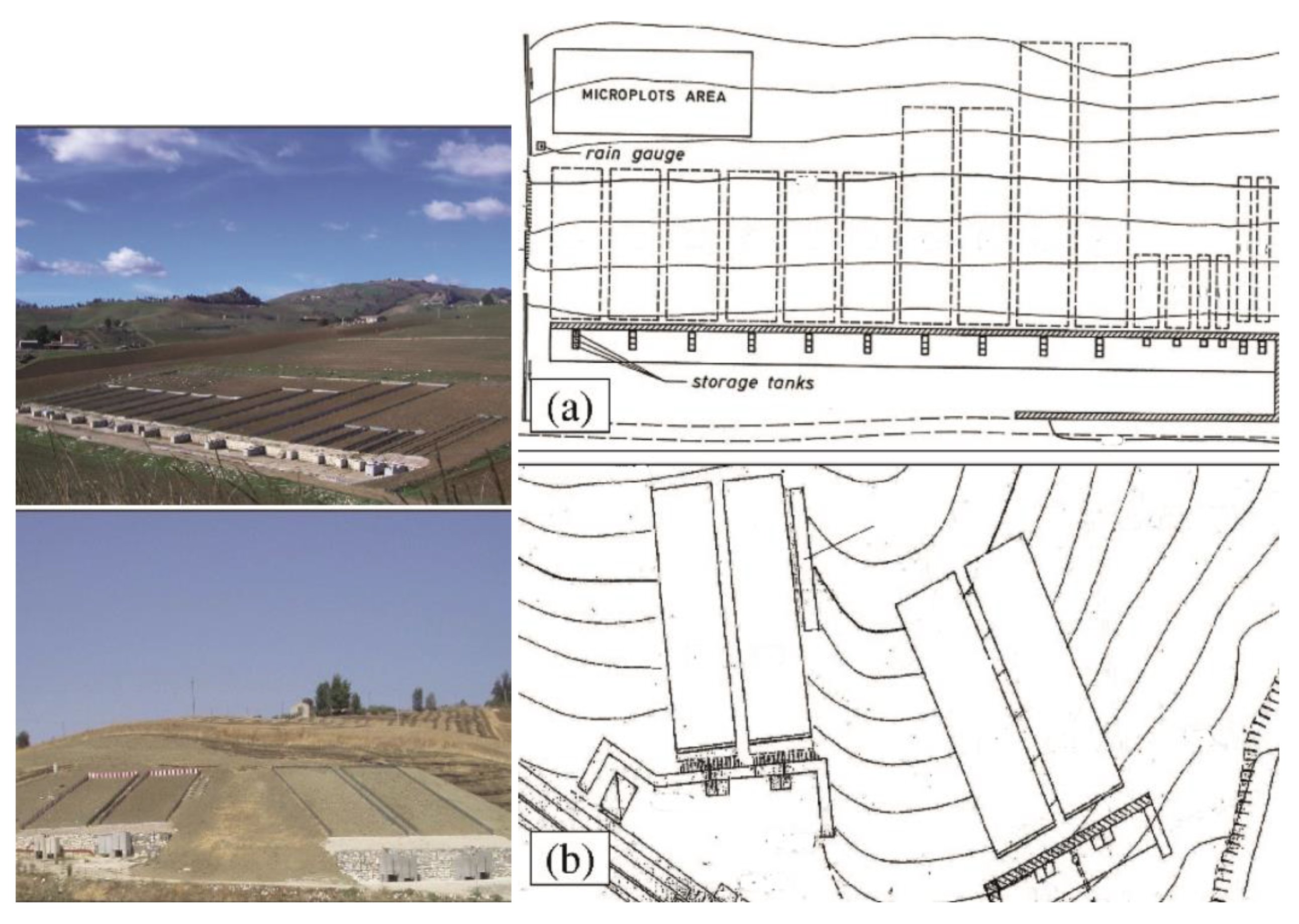
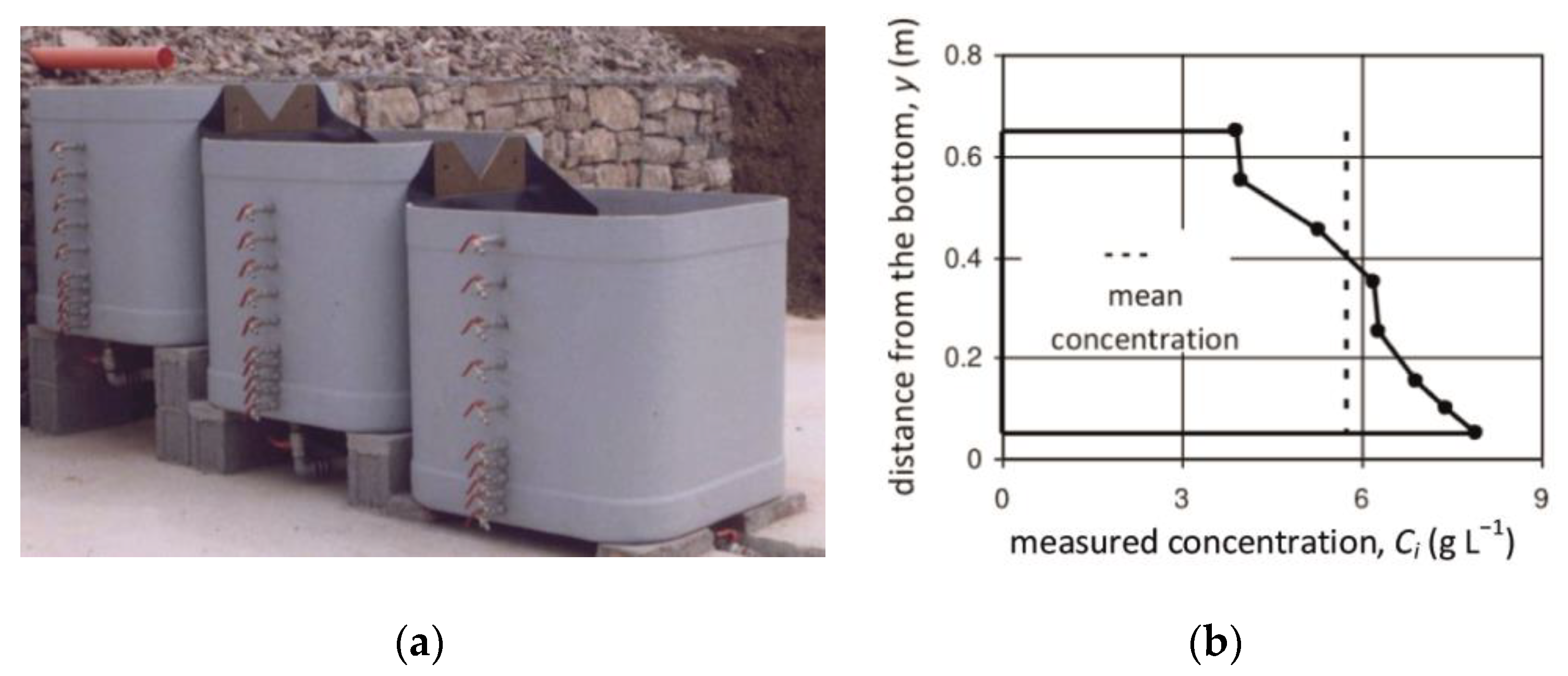
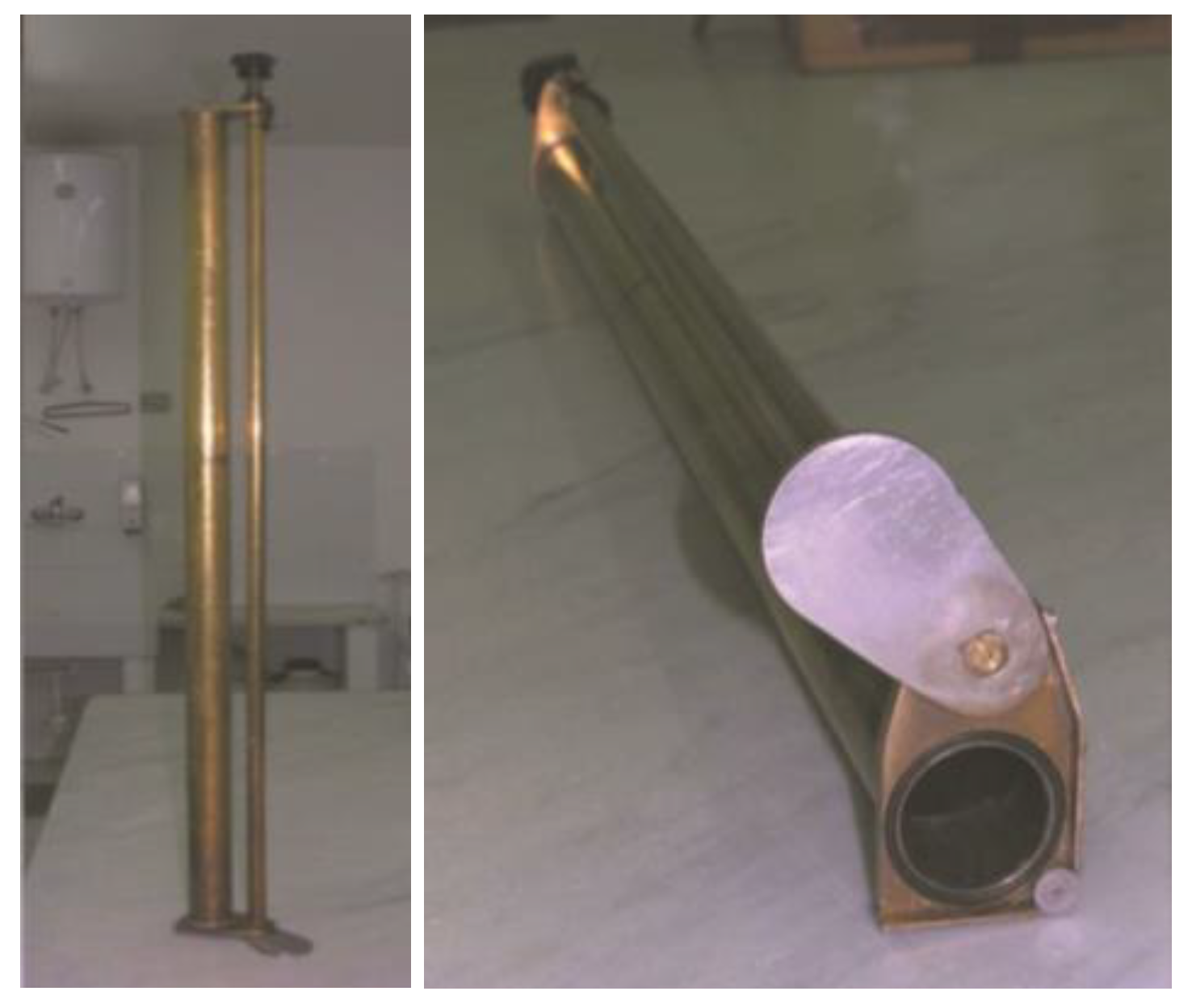
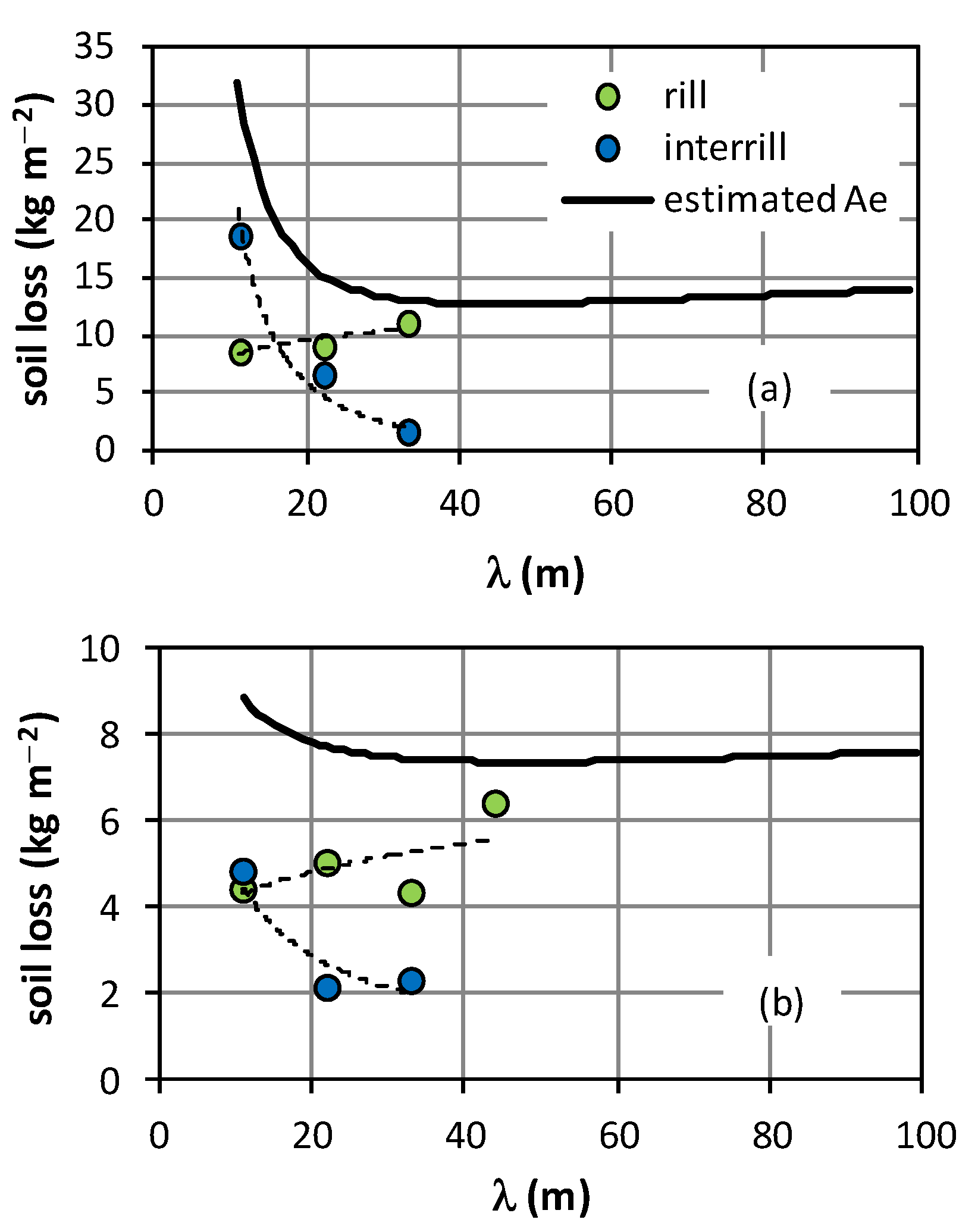
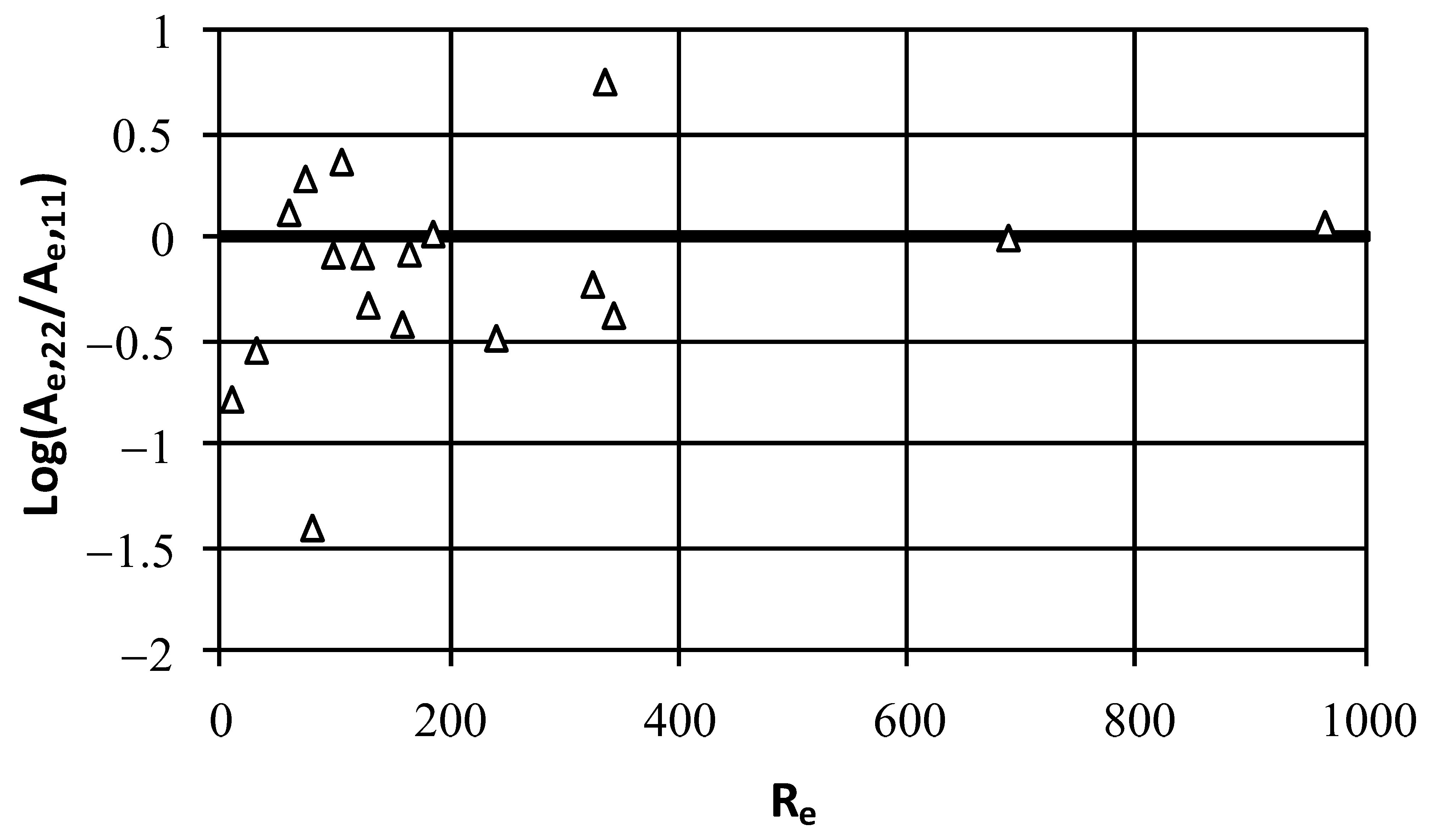
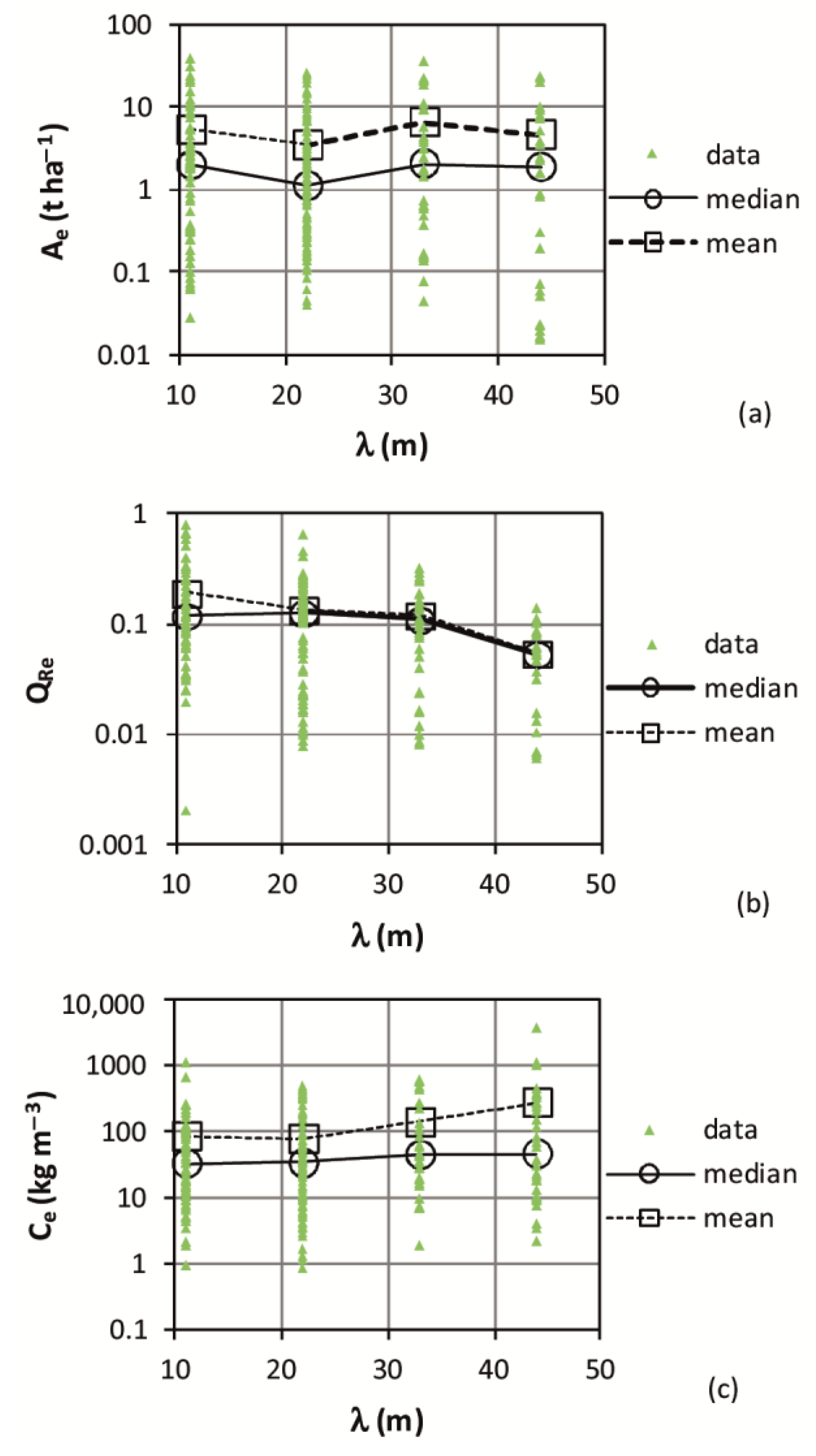
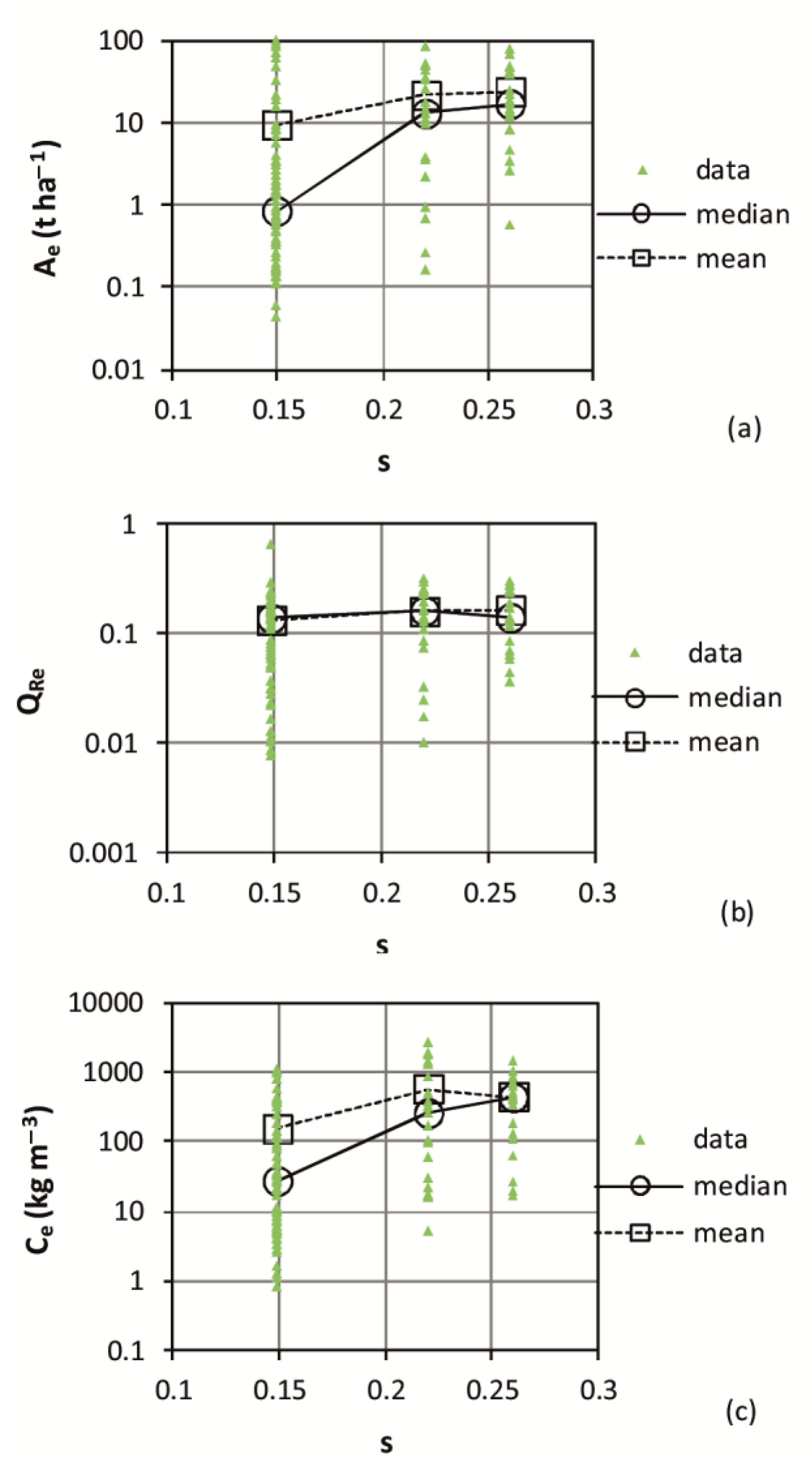
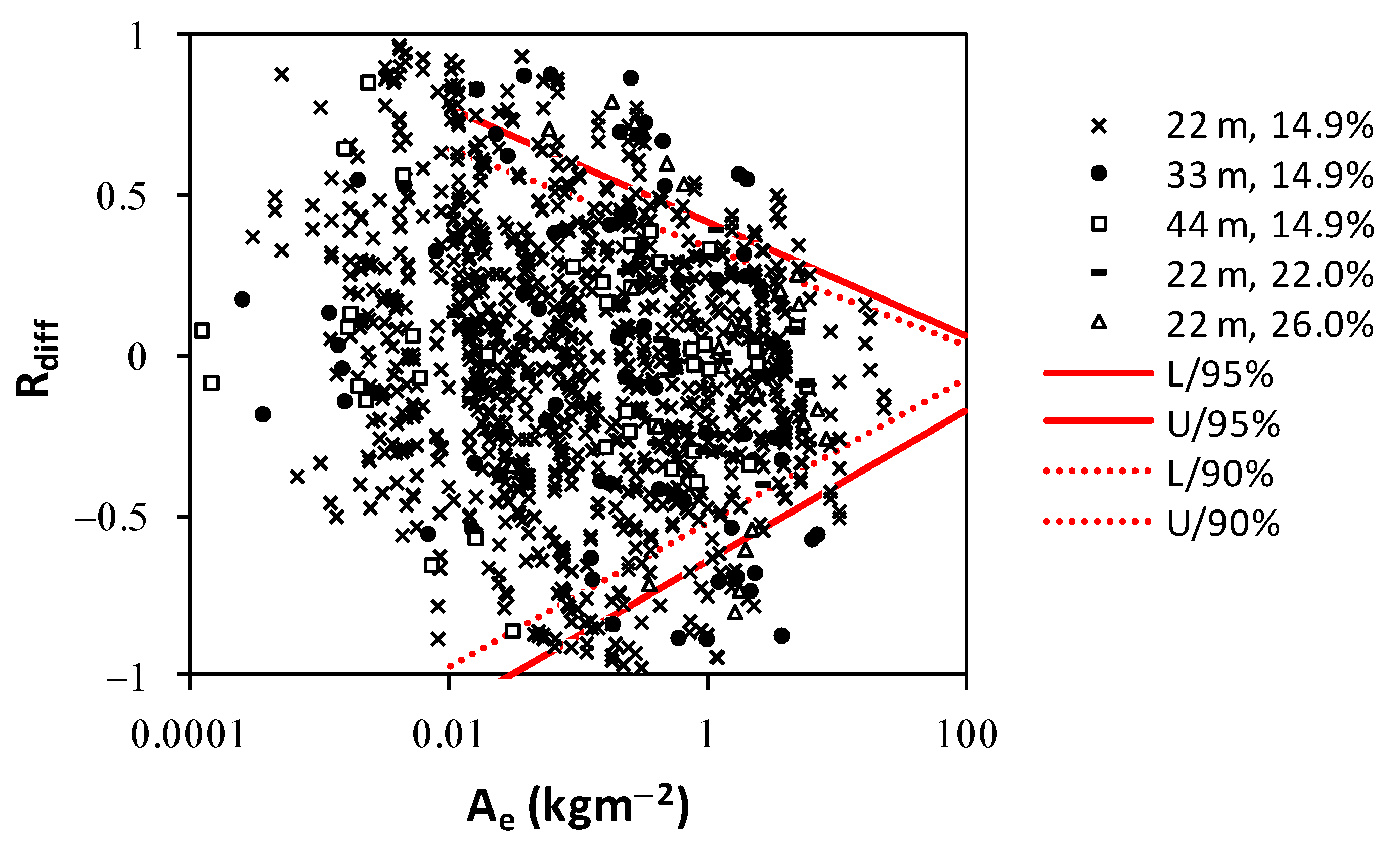
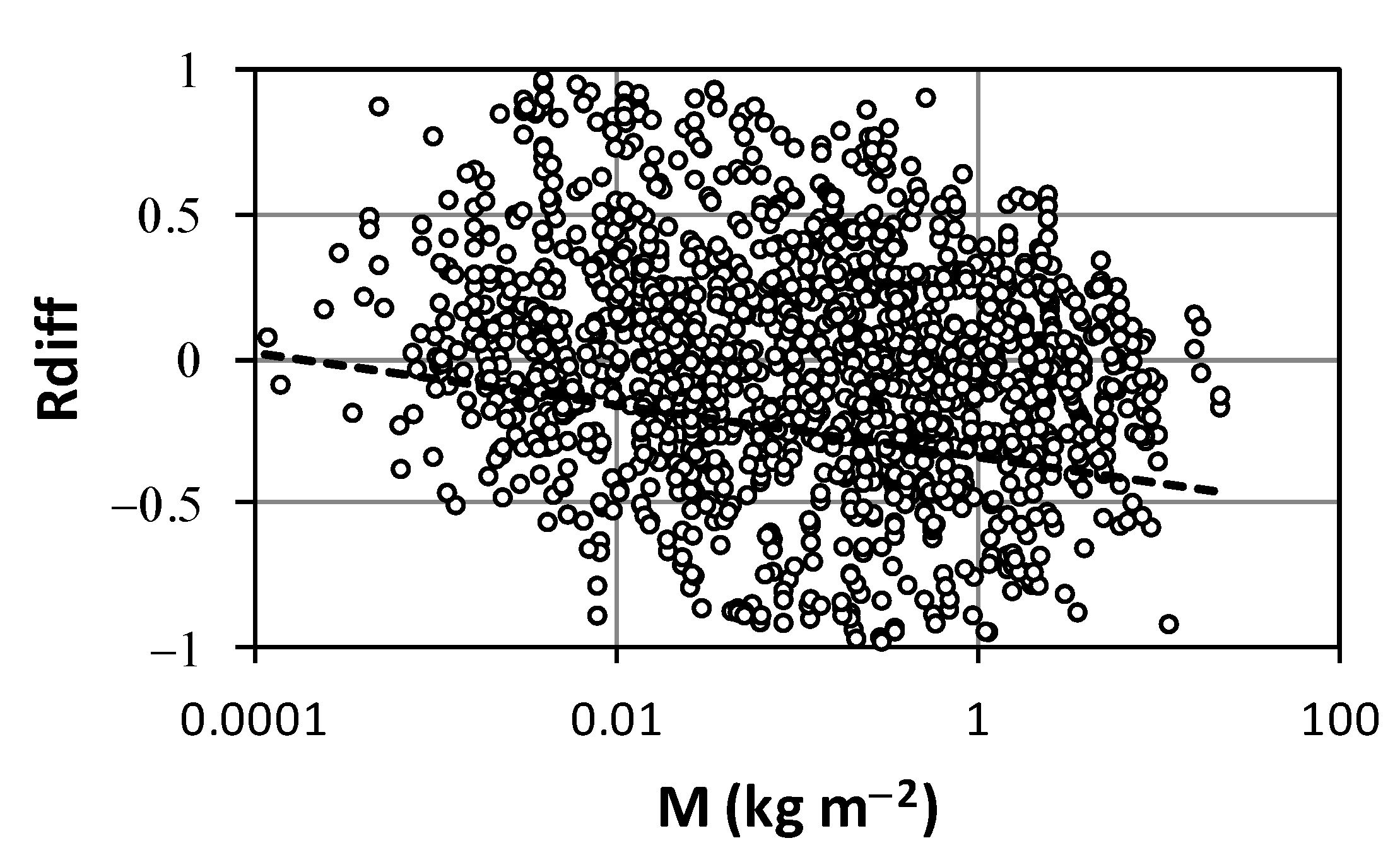
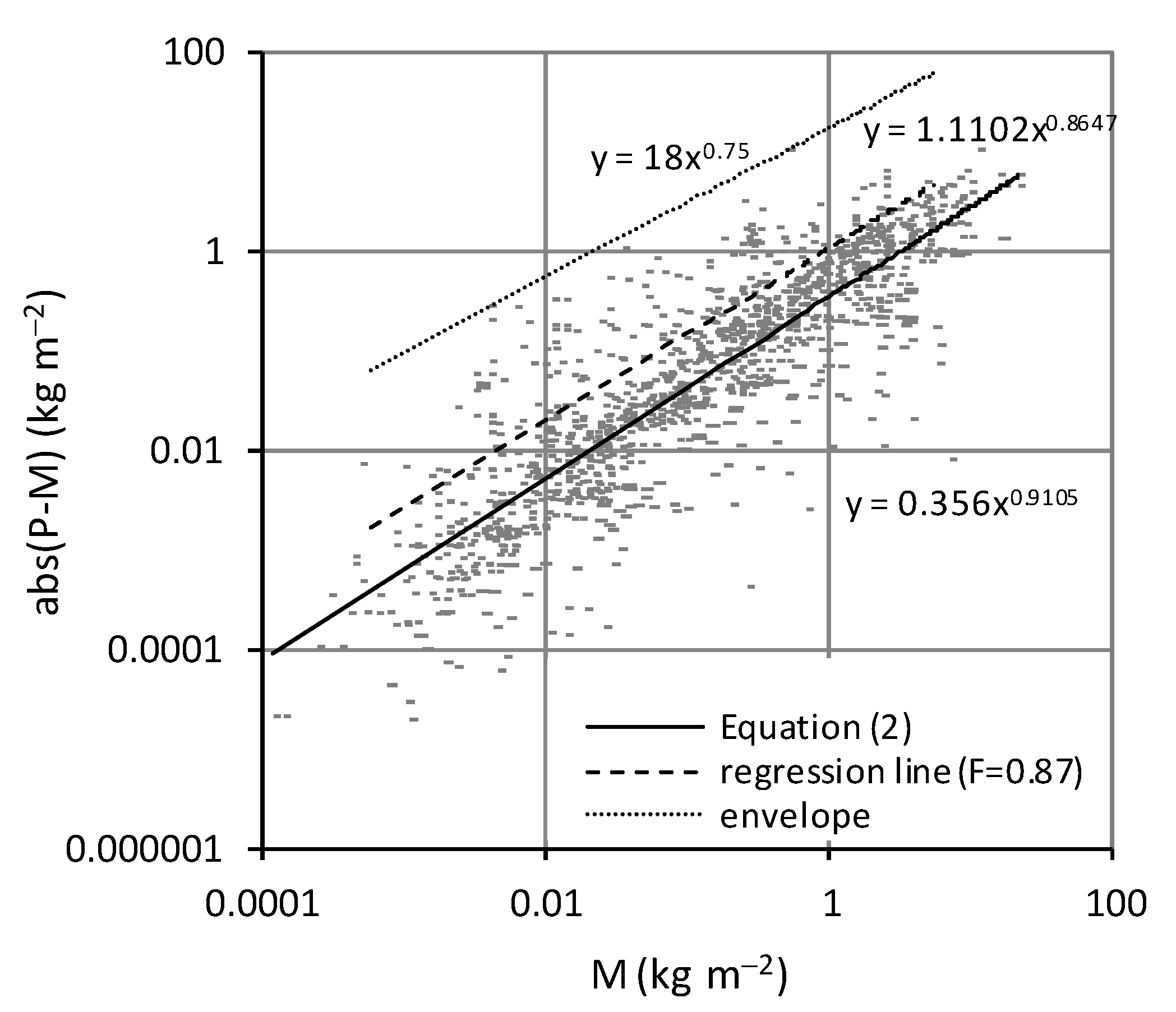




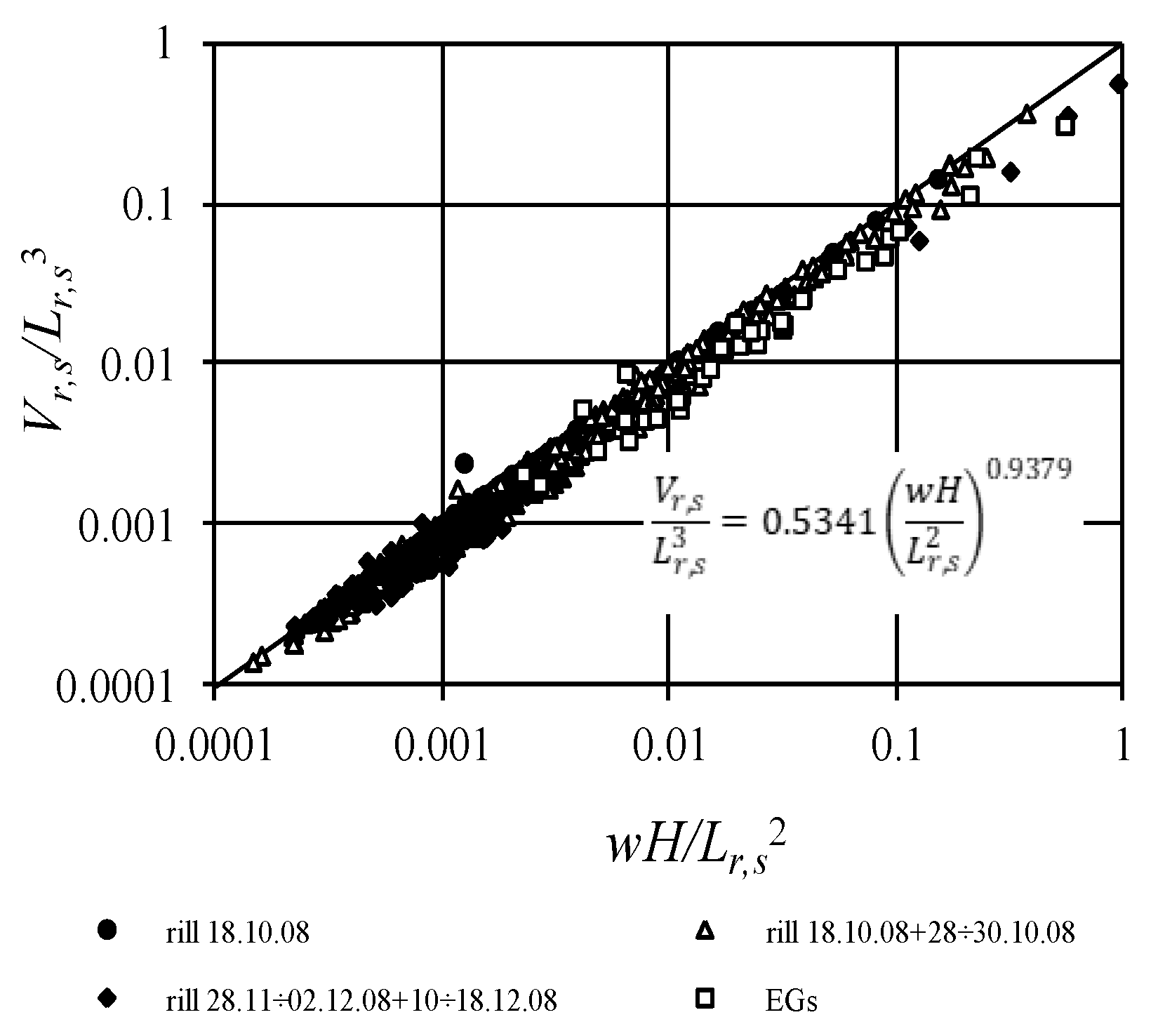
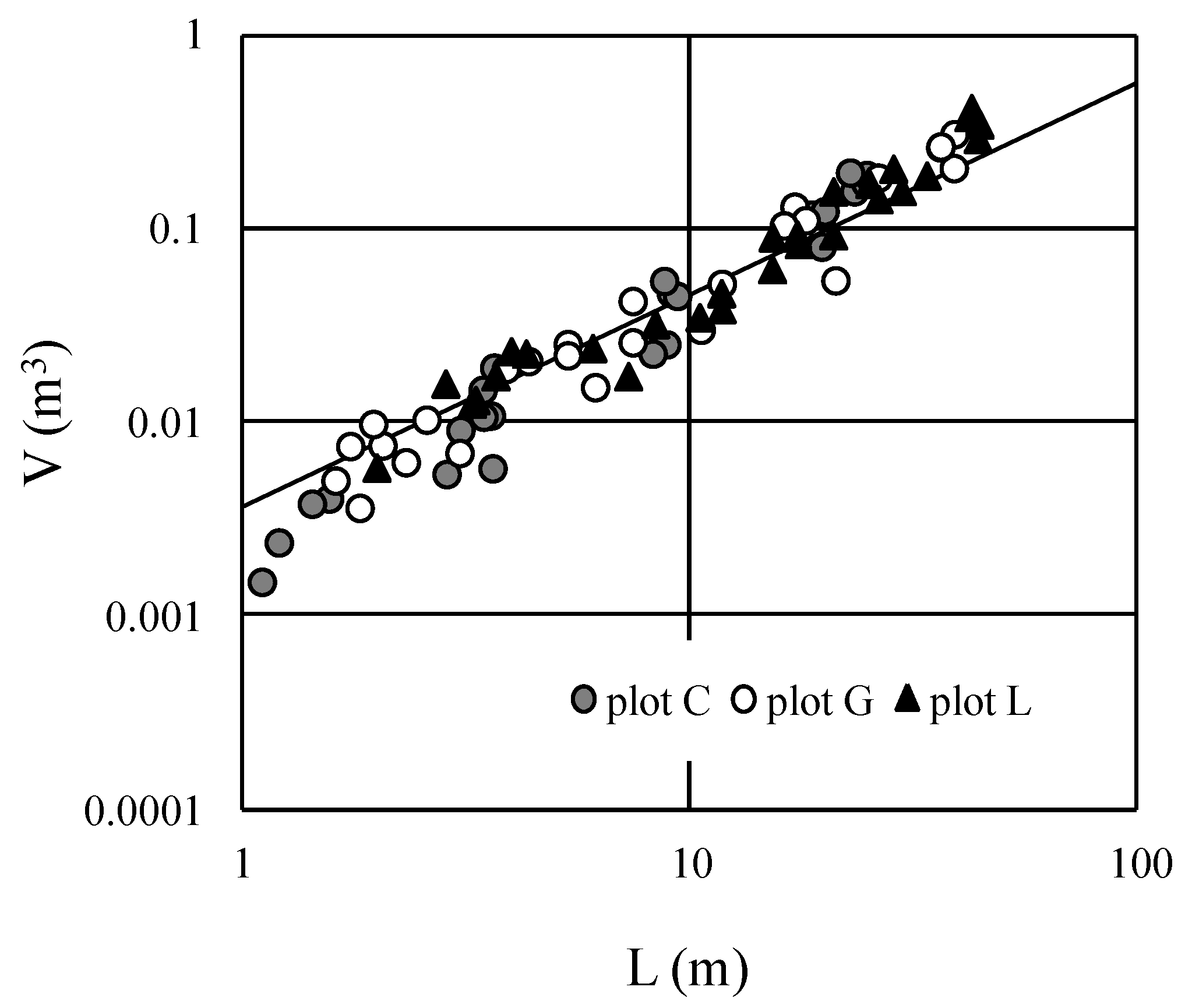
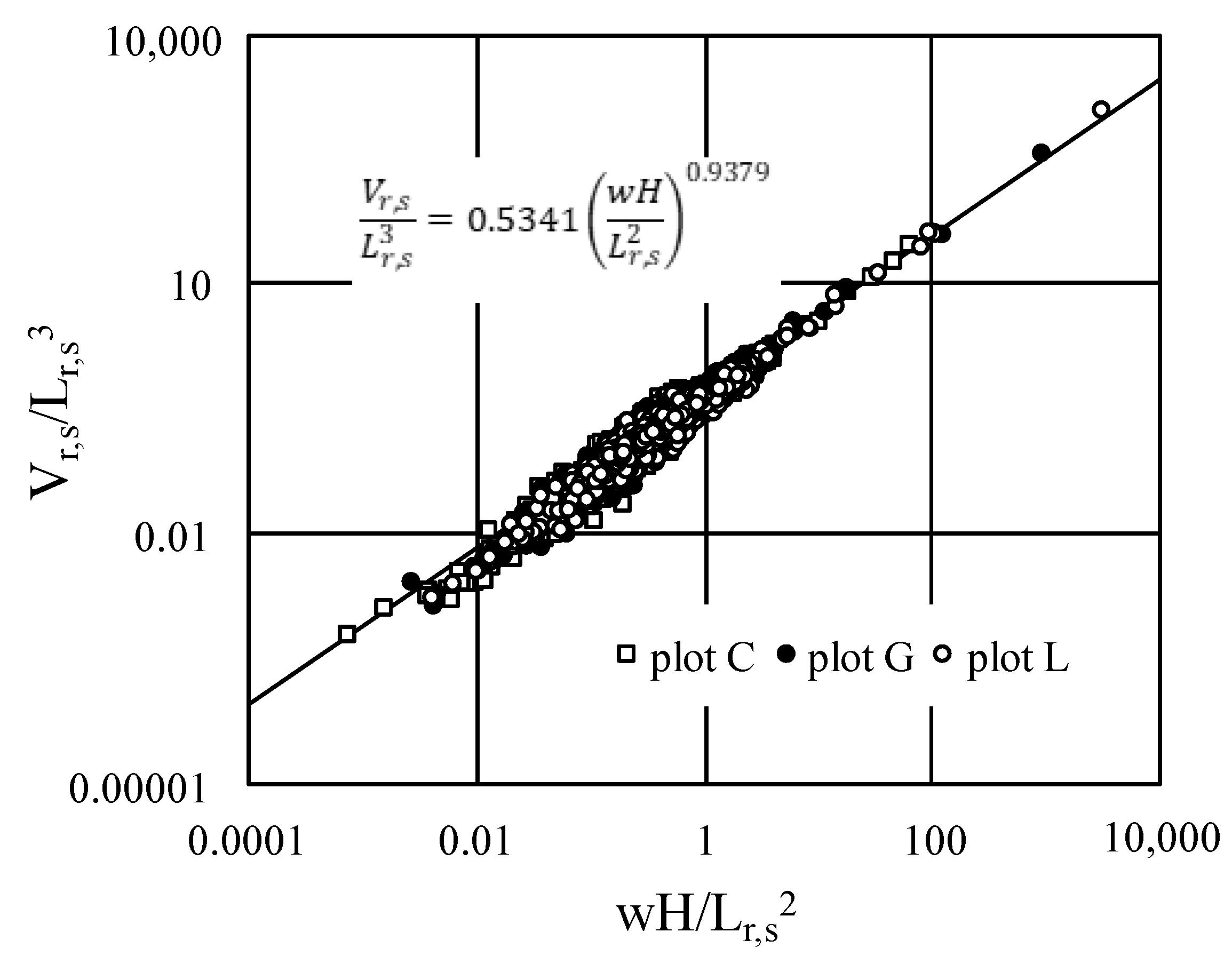
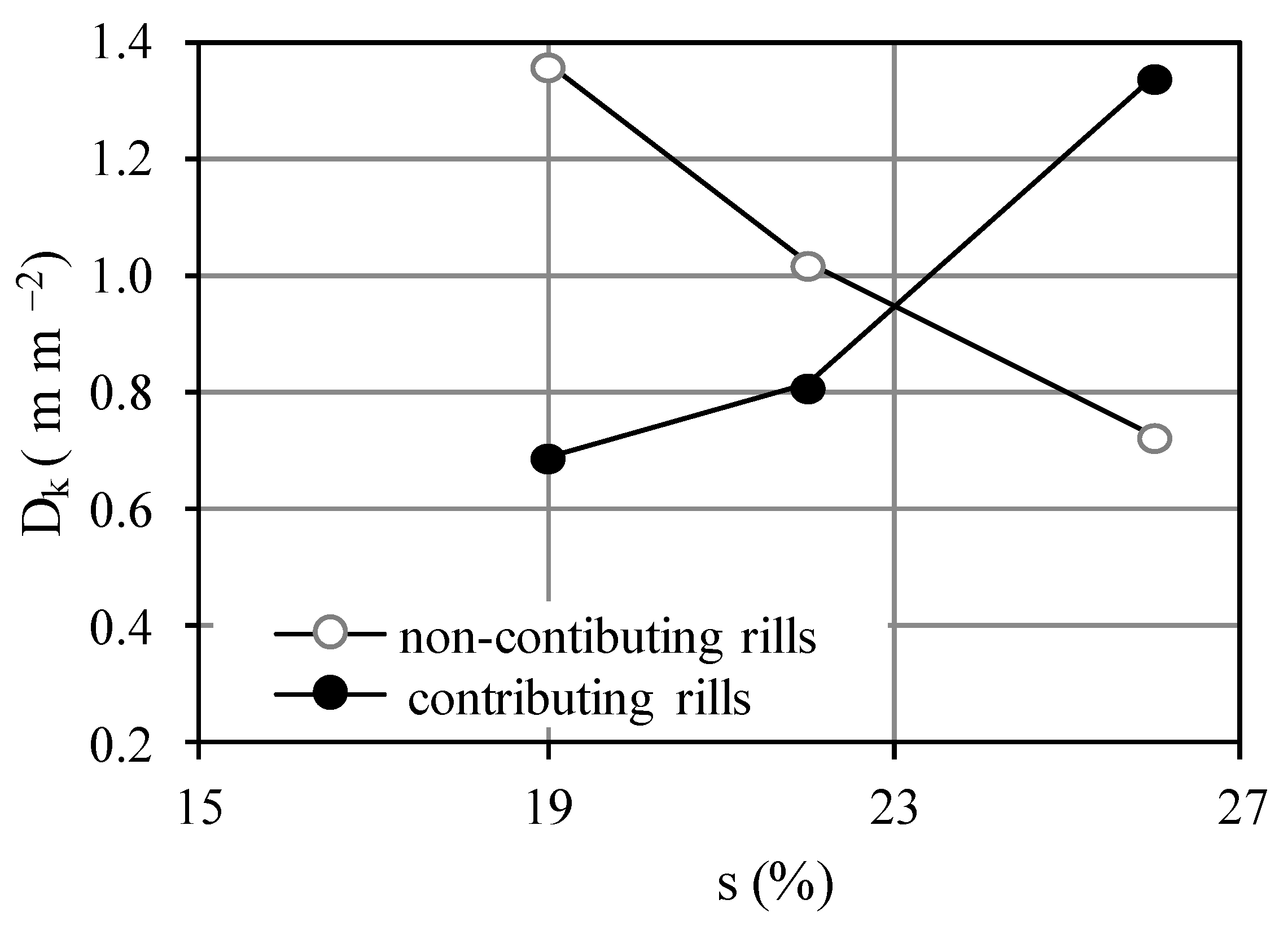

Publisher’s Note: MDPI stays neutral with regard to jurisdictional claims in published maps and institutional affiliations. |
© 2022 by the authors. Licensee MDPI, Basel, Switzerland. This article is an open access article distributed under the terms and conditions of the Creative Commons Attribution (CC BY) license (https://creativecommons.org/licenses/by/4.0/).
Share and Cite
Pampalone, V.; Carollo, F.G.; Nicosia, A.; Palmeri, V.; Di Stefano, C.; Bagarello, V.; Ferro, V. Measurement of Water Soil Erosion at Sparacia Experimental Area (Southern Italy): A Summary of More than Twenty Years of Scientific Activity. Water 2022, 14, 1881. https://doi.org/10.3390/w14121881
Pampalone V, Carollo FG, Nicosia A, Palmeri V, Di Stefano C, Bagarello V, Ferro V. Measurement of Water Soil Erosion at Sparacia Experimental Area (Southern Italy): A Summary of More than Twenty Years of Scientific Activity. Water. 2022; 14(12):1881. https://doi.org/10.3390/w14121881
Chicago/Turabian StylePampalone, Vincenzo, Francesco Giuseppe Carollo, Alessio Nicosia, Vincenzo Palmeri, Costanza Di Stefano, Vincenzo Bagarello, and Vito Ferro. 2022. "Measurement of Water Soil Erosion at Sparacia Experimental Area (Southern Italy): A Summary of More than Twenty Years of Scientific Activity" Water 14, no. 12: 1881. https://doi.org/10.3390/w14121881
APA StylePampalone, V., Carollo, F. G., Nicosia, A., Palmeri, V., Di Stefano, C., Bagarello, V., & Ferro, V. (2022). Measurement of Water Soil Erosion at Sparacia Experimental Area (Southern Italy): A Summary of More than Twenty Years of Scientific Activity. Water, 14(12), 1881. https://doi.org/10.3390/w14121881






